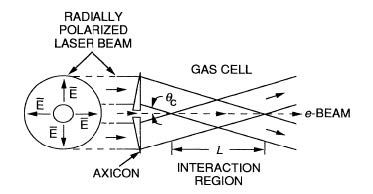- Home
- Capabilities
- Science Highlights
- Operations
- Publications
-
ES&H
- Experiment Start-up
- Laser Safety
Collider-Accelerator Dept.
- C-AD ES&H Resources
- Staff
- Users' Place
- Apply for Access
First Demonstration of Inverse Cerenkov Electron Acceleration
The idea of the experiment first proposed by Professors Pantel and Fontana from Stanford University in 1982 was to reverse the Cherenkov effect by accelerating electrons with a laser light intersecting the electron path at the Cherenkov angle ???? = ??????-1(1/????), where n is the index of refraction of the gas, and ß is the electron’s velocity divided by that of the light. To satisfy phase matching, hydrogen gas was employed to decrease the phase velocity of the laser light to match the electron’s velocity so assuring that the electrons stayed in phase with the light wave and gained energy from the laser. The long wavelength CO2 laser allows a long phase slippage distance of the accelerating electron and big gains in accumulated energy. The principle diagram of the ATF experiment is shown below.

Configuration of an inverse Cherenkov acceleration experiment. A radially polarized laser beam is focused by an axicon at the Cherenkov angle inside a gas-filled cell, leading to an energy exchange over the interaction length, L.
In addition to the special method of focusing the laser with an axicon, the experiment embodied an intricate radial polarizer setup based on spiral phase-delay plates. This configuration assured the achievement of 3.7 MeV acceleration over 12 cm interaction length with just 580 MW of acting laser power. Published in 1995, the experiment became the first convincing demonstration of the direct energy transfer from laser to the electron bunch; it resides now in the classic library of the Advanced Accelerator research with an impressive number of citations.
Kimura, W.D., et al., Laser Acceleration of Relativistic Electrons using the Inverse Cherenkov Effect. Phys.Rev. Lett., 1995. 74: p. 546-549.




